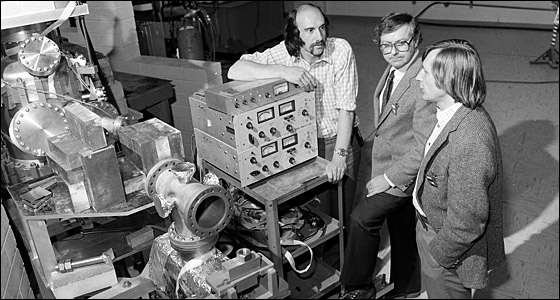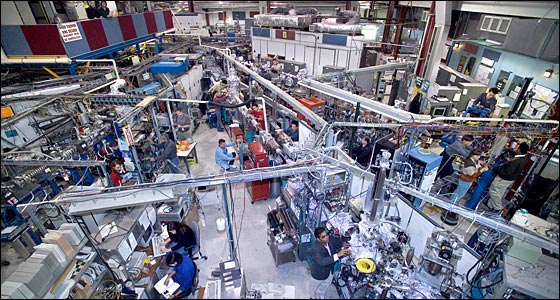BNL Timeline
APS Historic Site Home > BNL Timeline > 1980-1990
1980-1990

NSLS scientists discuss the first beamline on the Vacuum Ultraviolet Ring, one of two synchrotron rings at NSLS
The National Synchrotron Light Source (NSLS) opens its doors, starting the Lab’s long-time commitment to photon science research. As the first facility dedicated to producing synchrotron radiation (particle physicists previously viewed synchrotron radiation as a nuisance because it sapped the energy from their machines), NSLS became a valuable tool for research in fields ranging from biology and chemistry to condensed matter physics and materials science.
For more than half a century, neutrons were the only experimental tools used to study magnetic structures and phase transitions. But at NSLS, a new technique — resonant magnetic x-ray scattering — is developed and used to explore a wide range of fundamental problems in magnetism.
At the High Flux Beam Reactor, scientists discover antiferromagnetism (a condition in which adjacent magnetic atoms have their north poles pointing in opposite directions) in parent compounds of high-temperature superconductors, materials that conduct electricity without resistance.
Scientists at Brookhaven and the Polytechnic Institute of Milan invent the silicon drift chamber, a detector used in experiments around the world.
BNL researchers propose the theory of self-organized criticality, a theory that links the behavior of complex natural phenomena to physics laws. And physicists at the Alternating Gradient Synchrotron begin producing polarized protons, protons whose spins have been aligned in the same direction, at the highest energy ever – 16.5 GeV.

The NSLS experimental floor
The Accelerator Test Facility starts providing experimenters with equipment to advance accelerator technology that’s small and more cost-effective. Operations also start at the Laser-Electron Accelerator Facility, a picosecond laser-electron accelerator facility at Brookhaven’s Center for Radiation Chemistry Research.
The Alternating Gradient Synchrotron (AGS) begins accelerating gold nuclei to study high-density matter, which, along with the already existing proton program, paves the way studies for at the Relativistic Heavy Ion Collider (RHIC). A few years later, AGS achieves the highest baryon (protons, neutrons, and other particles made up of quarks) density in gold-gold collisions. Scientists at the AGS also spot (for a second time) one of the rarest occurrences in the subatomic world: the decay of a kaon into a positively charged pion, a neutrino, and an antineutrino.
As part of the lead-up to RHIC, the RIKEN-BNL Research Center is established and dedicated to the study of spin physics and quantum chromodynamics (QCD) the model of matter based on the “strong force” that binds quarks and gluons in the particles that make up the center of every atom in the universe.
At the National Synchrotron Light Source, researchers discover that a fundamental type of energy state known as a “quantum well” can be spin-polarized. Other condensed matter physicists find evidence that the electronic structure of high-temperature superconductors consists of fluctuating strings of charge, known as stripes.
With positron emission tomography, the development of which was pioneered at BNL, Brookhaven scientists are the first to report that people addicted to cocaine, alcohol, and heroin show reduced activity in their brain’s dopamine system.